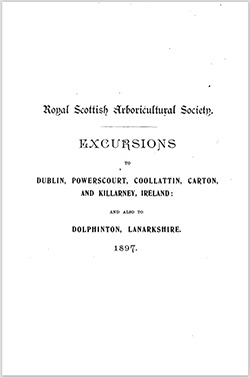 About 110 members of the Royal Scottish Arboricultural Society, established in 1854 (since 1930 the Royal Scottish Forestry Society), visited several notable collections of trees in Ireland during the latter part of August 1897. Initially, they spent four days within 100km of Dublin, then four days in the Killarney area and in West Cork. The report is notable chiefly for its careful account of the sizes of trees, commonly listing height, girth and crown spread, with some estimates (or, for younger trees, more certain records) of tree age: in the Phoenix Park, and in the collections at Powerscourt, Charleville, Killruddery, Coolattin, Trinity College Botanic Gardens, Hamwood, and Carton. These records may be the earliest printed records of the sizes of trees in these places, and are of historical interest: several trees undoubtedly survive today, and may probably be revisited from the careful descriptions of their locations. Indeed, the extensive accounts (62 pages on the Dublin region) are remarkably informative, not least for their social commentaries.
About 110 members of the Royal Scottish Arboricultural Society, established in 1854 (since 1930 the Royal Scottish Forestry Society), visited several notable collections of trees in Ireland during the latter part of August 1897. Initially, they spent four days within 100km of Dublin, then four days in the Killarney area and in West Cork. The report is notable chiefly for its careful account of the sizes of trees, commonly listing height, girth and crown spread, with some estimates (or, for younger trees, more certain records) of tree age: in the Phoenix Park, and in the collections at Powerscourt, Charleville, Killruddery, Coolattin, Trinity College Botanic Gardens, Hamwood, and Carton. These records may be the earliest printed records of the sizes of trees in these places, and are of historical interest: several trees undoubtedly survive today, and may probably be revisited from the careful descriptions of their locations. Indeed, the extensive accounts (62 pages on the Dublin region) are remarkably informative, not least for their social commentaries.
One may admire, if not perhaps emulate, the activity of the participants: staying at the Gresham Hotel, they visited both Trinity Botanic Gardens and the RDS in Ballsbridge (starting at 06.00) before leaving the city (on “a dozen of well-horsed and commodious brakes”) for Carton and Hamwood at 09.00! Another day, they departed Dublin at 08.00 by train for Bray, thence to see three great gardens of Wicklow. A special train to Shillelagh was provided for their visit to Coolattin, a place – some 100 years later – of inspiration to the nascent Irish Tree Society, as Thomas Pakenham has recorded in The Company of Trees. This is, unquestionably, a vivid account of a well-informed excursion to see specimen trees, with commentaries on the scenery of estates and countryside. The vagaries of taxonomic nomenclature may be initially confusing: for example, Abies Douglasii = Pseudostuga menziesii, Abies pectinata = A. alba, Araucaria imbricata = A. araucana, Pinus insignis = P. radiata, and others; but the current names are easily detectable by a quick Google search.
